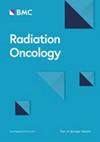全身照射后长期存活者的继发性实体恶性肿瘤
IF 3.3
2区 医学
Q2 ONCOLOGY
引用次数: 0
摘要
全身照射(TBI)为基础的同种异体造血干细胞移植(allo-HSCT)是治疗部分急性髓性白血病(AML)患者的一种治愈性疗法。然而,继发性恶性肿瘤会导致长期发病率和死亡率,而TBI可能会影响这些风险。这项回顾性研究分析了2000年至2016年期间,89名连续AML患者在首次allo-HSCT前接受基于TBI的调理后,继发性实体恶性肿瘤和癌前病变的累积发病率。TBI的平均剂量率为4 cGy/min,每天分次进行。病因特异性危险模型分析了继发性恶性肿瘤/癌前病变的风险因素以及在发生继发性恶性肿瘤/癌前病变前死亡的竞争风险。患者TBI时的中位年龄为42.5岁(四分位间范围为32.5-51.2岁),中位随访时间为15.2年(四分位间范围为13.0-18.2年)。大多数患者接受了含8 Gy(47人)和12 Gy TBI(11人)的髓鞘脱落调理(MAC)。31名患者接受了降低强度方案(RIC,4 Gy TBI)。值得注意的是,接受 RIC 治疗的患者年龄比接受 MAC 治疗的患者大。最常见的癌症类型是非鳞状细胞癌(14 例),其中排除了一名在 TBI 后不到一年内确诊为肉瘤的患者。继发性恶性肿瘤和癌前病变的累积发病率在10、15和20年分别为8%(95%CI,4-16)、14%(95%CI,7-23)和17%(95%CI,9-27),而过早死亡的累积发病率分别为59%(95%CI,48-69)、59%(95%CI,48-69)和64%(95%CI,49-76)。在多变量分析中,TBI时患者年龄越大,继发性恶性肿瘤/癌前病变的发生率越低,而患者年龄越大,则有过早死亡的趋势(在患者发生恶性肿瘤之前)。较高剂量的创伤性脑损伤(主要用于年轻患者)可降低继发性恶性肿瘤/癌前病变的发生率,但与死亡率无关。需要全身免疫抑制的慢性坏死性疾病与过早死亡有关。尽管这项研究表明,创伤性脑损伤的应用剂量与治疗相关恶性肿瘤之间存在反比关系,但竞争风险的混杂因素依然存在。年龄依赖性的原因可能是老年患者的预期寿命较短,而与恶性肿瘤无关,这说明了竞争风险的隐患。该研究为回顾性登记。本文章由计算机程序翻译,如有差异,请以英文原文为准。
Secondary solid malignancies in long-term survivors after total body irradiation
Total body irradiation (TBI)-based allogeneic hematopoietic stem cell transplantation (allo-HSCT) is a curative treatment for selected patients with acute myeloid leukemia (AML). Yet, secondary malignancies contribute to long-term morbidity and mortality with TBI potentially influencing these risks. This retrospective study analyzed the cumulative incidences of secondary solid malignancies and precancerous lesions of 89 consecutive AML patients after TBI-based conditioning before 1st allo-HSCT between 2000 and 2016. TBI was performed with an average dose rate of 4 cGy/min and a twice-daily fractionation. Cause-specific hazard models analyzed risk factors for secondary malignancies/precancerous lesions and the competing risks of dying before developing secondary malignancies/precancerous lesions. The median patient age at TBI was 42.5 years (interquartile range, 32.5–51.2), while the median follow-up was 15.2 years (interquartile range, 13.0-18.2). Most patients received a myeloablative conditioning (MAC) containing 8 Gy (n = 47) and 12 Gy TBI (n = 11). Reduced-intensity regimens (RIC, 4 Gy TBI) were applied in 31 patients. Of note, patients receiving RIC were older than patients receiving MAC. The most common cancer types were non-squamous cell carcinomas (n = 14) after exclusion of a patient diagnosed with sarcoma within less than a year after TBI. The cumulative incidences of secondary malignancies and precancerous lesions were 8% (95%CI, 4–16), 14% (95%CI, 7–23), and 17% (95%CI, 9–27) at 10, 15 and 20 years, while the cumulative incidences of premature deaths were 59% (95%CI, 48–69), 59% (95%CI, 48–69), and 64% (95%CI, 49–76). In multivariate analyses, higher patient age at TBI was associated with lower rates of secondary malignancies/precancerous lesions, while higher patient age translated into a trend towards premature deaths (before patients could develop malignancies). Higher TBI doses, mainly applied in younger patients, translated into lower rates of secondary malignancies/precancerous lesions while lacking associations with mortality. Chronic GVHD requiring systemic immunosuppression was associated with premature deaths. Although this study indicates an inverse relationship between TBI doses applied and treatment-related malignancies, confounding by competing risks is present. The age dependency may be explained by the fact that older patients had a lower life expectancy independent of malignancies, illustrating the pitfalls of competing risks. The study was retrospectively registered.
求助全文
通过发布文献求助,成功后即可免费获取论文全文。
去求助
来源期刊

Radiation Oncology
ONCOLOGY-RADIOLOGY, NUCLEAR MEDICINE & MEDICAL IMAGING
CiteScore
6.50
自引率
2.80%
发文量
181
审稿时长
3-6 weeks
期刊介绍:
Radiation Oncology encompasses all aspects of research that impacts on the treatment of cancer using radiation. It publishes findings in molecular and cellular radiation biology, radiation physics, radiation technology, and clinical oncology.
 求助内容:
求助内容: 应助结果提醒方式:
应助结果提醒方式:


